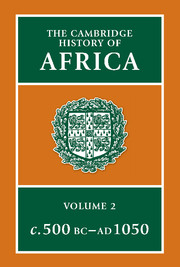Book contents
- Frontmatter
- Introduction
- 1 The legacy of prehistory: an essay on the background to the individuality of African cultures
- 2 North Africa in the period of Phoenician and Greek colonization, c. 800 to 323 BC
- 3 North Africa in the Hellenistic and Roman periods, 323 BC to AD 305
- 4 The Nilotic Sudan and Ethiopia, c. 660 bc to c.ad 600
- 5 Trans-Saharan contacts and the Iron Age in West Africa
- 6 The emergence of Bantu Africa
- 7 The Christian period in Mediterranean Africa, c.ad 200 to 700
- 8 The Arab conquest and the rise of Islam in North Africa
- 9 Christian Nubia
- 10 The Fatimid revolution (861–973) and its aftermath in North Africa
- 11 The Sahara and the Sudan from the Arab conquest of the Maghrib to the rise of the Almoravids
- Bibliographical essays
- Bibliography
- Index
- Plate Sections
- Plate Sections
- Plate Sections
- References
8 - The Arab conquest and the rise of Islam in North Africa
Published online by Cambridge University Press: 28 March 2008
- Frontmatter
- Introduction
- 1 The legacy of prehistory: an essay on the background to the individuality of African cultures
- 2 North Africa in the period of Phoenician and Greek colonization, c. 800 to 323 BC
- 3 North Africa in the Hellenistic and Roman periods, 323 BC to AD 305
- 4 The Nilotic Sudan and Ethiopia, c. 660 bc to c.ad 600
- 5 Trans-Saharan contacts and the Iron Age in West Africa
- 6 The emergence of Bantu Africa
- 7 The Christian period in Mediterranean Africa, c.ad 200 to 700
- 8 The Arab conquest and the rise of Islam in North Africa
- 9 Christian Nubia
- 10 The Fatimid revolution (861–973) and its aftermath in North Africa
- 11 The Sahara and the Sudan from the Arab conquest of the Maghrib to the rise of the Almoravids
- Bibliographical essays
- Bibliography
- Index
- Plate Sections
- Plate Sections
- Plate Sections
- References
Summary
PROBLEMS OF SOURCES
The Arab conquests, which created a great new empire and led to the establishment of Islam as one of the great religions of the world, are one of the traditional landmarks of history. For European historians they are a part of that perennial problem, the transition from the ancient to the medieval world. Conventionally it was the conquests themselves in the seventh century AD which were decisive; or, with greater refinement, it has been suggested that the landmark should be placed in the eighth, when the caliphate was transferred from Damascus to Baghdad. The most celebrated opinion of the last fifty years is that of Pirenne, who argued that the Arab conquest of the eastern and southern Mediterranean cut off western Europe from the long-distance trade on which its economy had depended, and drove it back into rudimentary self-sufficiency. The criticism to which this theory has been subjected, however, illustrates the elementary point that the introduction of a new language into the sources, whatever it may be said to represent, has created a separate discipline to rank with the study of medieval Latin and Byzantine Greek among the successors to the Classics. At the same time the primarily European concern of Pirenne's hypothesis indicates the major interest of historians and the disparity of these disciplines in terms of the attention each has hitherto received. In this way the problems of Mediterranean history have been complicated rather than clarified; there has been neither a global treatment nor an adequate specialization. It is therefore ironic that the Arab conquests and the appearance of Islam in Africa should have been judged by those historians concerned with the more recent discipline of African history to represent the arrival on the continent of a unifying factor not only in terms of culture, but more basically in terms of source materials.
- Type
- Chapter
- Information
- The Cambridge History of Africa , pp. 490 - 555Publisher: Cambridge University PressPrint publication year: 1979
References
- 12
- Cited by

